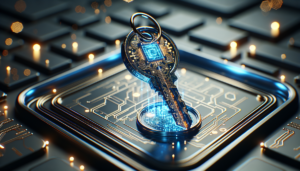Have you ever thought about how secure our online information really is? In a world where digital threats seem to lurk around every corner, it’s crucial to find technologies that can keep our data safe. One such technology that has risen to prominence is blockchain. As I explore this fascinating subject, let’s unravel the impact of blockchain on digital security together.
Understanding Blockchain
At its core, blockchain is a decentralized ledger technology that enables the secure storage of information across multiple computers. Each piece of data is stored in a “block,” and these blocks are linked together in a chronological “chain.” This structure makes it incredibly difficult for anyone to tamper with the data, which is a fundamental aspect of digital security.
When I first learned about blockchain, I was struck by its potential to revolutionize how we think about data integrity and trust. Unlike traditional databases that are controlled by a single entity, blockchain operates on a network of computers, or nodes, which work together to validate and record transactions. This decentralized nature means that there isn’t a single point of failure, making it far more resilient against attacks.
Key Characteristics of Blockchain
To fully appreciate the impact of blockchain on digital security, it’s important to understand its key characteristics:
-
Decentralization: This is the heart of blockchain technology. By distributing information across a network of computers, the risk of a single point of failure is eliminated. If one node goes down, the others can continue to operate normally.
-
Transparency: All transactions on the blockchain are visible to all participants in the network. This transparency fosters trust among users, as they can independently verify the authenticity of data without relying on a central authority.
-
Immutability: Once a block is added to the chain, it cannot be altered or deleted. This feature significantly enhances data integrity, ensuring that records remain accurate and tamper-proof over time.
-
Security through Cryptography: Blockchain utilizes advanced cryptographic techniques to secure data. Each block contains a unique cryptographic hash of the previous block, making it virtually impossible for anyone to alter past blocks without invalidating the entire chain.
-
Consensus Mechanisms: Blockchain networks use consensus algorithms to agree on the validity of transactions. This means that all parties involved must come to an agreement before any new information is added, preventing fraud.
How Blockchain Enhances Digital Security
With these characteristics in mind, I find it fascinating to see how blockchain enhances digital security across various domains:
Securing Financial Transactions
One of the most prominent applications of blockchain is in the financial sector, where I often hear about cryptocurrencies like Bitcoin. These digital currencies utilize blockchain to create a secure, transparent, and immutable record of transactions. By eliminating intermediaries, blockchain reduces costs and speeds up transactions while enhancing security.
In traditional banking systems, sensitive data can be vulnerable to hacking and fraud. Blockchain’s decentralized nature safeguards personal and financial information by ensuring that it is not stored in a single location, making it much less appealing to cybercriminals.
Protecting Personal Identity
Identity theft is becoming increasingly common, and it can have devastating consequences. Blockchain technology offers a solution by allowing individuals to control their digital identities. Instead of relying on centralized databases vulnerable to breaches, I can store my identity credentials securely on the blockchain.
By using cryptographic methods, I can verify my identity without exposing sensitive information to third parties. This way, even if someone were to try to access my data, they would only find encrypted information that is useless without the proper decryption keys.
The Role of Smart Contracts
Not only does blockchain secure transactions, but it also enables the creation of smart contracts. These self-executing contracts automatically enforce the terms of an agreement between parties without the need for intermediaries.
How Smart Contracts Work
When I engage in a transaction that uses a smart contract, the conditions agreed upon are written into code and stored on the blockchain. Once the predetermined conditions are met, the contract executes itself automatically. This reduces the risk of human error and fraud, making transactions much safer.
By eliminating the need for a middleman, smart contracts save time and costs while providing a secure environment for a variety of applications, from real estate transactions to supply chain management.
Applications of Blockchain in Cybersecurity
As I look deeper into the landscape of cybersecurity, it’s clear that blockchain’s potential extends beyond just financial services. Here are some applications where blockchain can significantly enhance security:
Data Integrity and Auditing
In any organization, maintaining the integrity of data is paramount. By using blockchain for storing critical records, companies can create an unalterable audit trail of who accessed the data, when, and what changes were made.
This capability can be particularly important in industries such as healthcare, where patient data must remain confidential and tamper-proof. If a data breach occurs, I can easily trace back to identify any unauthorized access and take necessary action.
Securing IoT Devices
The Internet of Things (IoT) connects our everyday devices to the internet, but it also introduces new security vulnerabilities. Each connected device represents a potential entry point for hackers. By leveraging blockchain, I can secure these devices through decentralized identification and authorization.
For example, I can create a blockchain-based identity for each IoT device, ensuring that only authorized devices can communicate within the network. This reduces the risk of data breaches and unauthorized access.
Challenges and Limitations of Blockchain
While blockchain holds great promise for enhancing digital security, it’s worth noting that it’s not a silver bullet. There are several challenges and limitations that I must consider:
Scalability Concerns
Many blockchain networks face scalability issues. As more transactions are added to the chain, the time it takes to process and validate them can significantly increase. This can be a barrier to widespread adoption, especially in industries that require rapid transactions.
Regulatory Uncertainty
The evolving landscape of regulations surrounding blockchain and cryptocurrencies can create uncertainty for businesses. As governments work to establish guidelines, I often wonder how this will impact innovation and adoption in the blockchain space.
Energy Consumption
Some consensus mechanisms, like proof-of-work, require significant energy to validate transactions. This has raised concerns about the environmental impact of blockchain technology. As I think about the future of blockchain, I hope to see advancements that can address this issue.
Future Prospects of Blockchain in Digital Security
Looking ahead, I am optimistic about the future of blockchain and its potential to reshape digital security. As the technology matures, I envision several trends that could enhance its effectiveness:
Integration with Artificial Intelligence
Combining blockchain with artificial intelligence (AI) could create a new paradigm for digital security. AI algorithms can analyze patterns and detect anomalies in real-time, while blockchain can provide a secure and transparent audit trail of all transactions and data access.
This integration could significantly improve threat detection and response times, making it easier for organizations to protect themselves against cyber threats.
Enhanced Privacy Solutions
With growing concerns over privacy and data ownership, blockchain will likely play a vital role in developing privacy-preserving technologies. Solutions like zero-knowledge proofs could allow me to prove certain information without revealing the underlying data, further enhancing privacy and security.
Decentralized Identity Management
The future of identity management may lie in decentralized systems powered by blockchain. Instead of relying on centralized databases, I can maintain control over my personal information, sharing only what is necessary for authentication purposes. This shift could drastically reduce identity theft and improve overall security.
Conclusion
In my journey through the world of blockchain and digital security, I’ve come to appreciate its immense potential to transform how we think about and manage our data. The key characteristics of blockchain—decentralization, transparency, immutability, and security through cryptography—work together to create a robust framework for safeguarding information.
While challenges remain, the future prospects for blockchain’s role in digital security are promising. As technology continues to evolve, I am excited to see how it can contribute to a safer and more secure digital landscape.
Understanding these aspects not only informs me about the current state of digital security but also empowers me to make better choices in the way I interact with technology. After all, in this fast-paced digital world, staying informed is the best way to protect what matters most.






